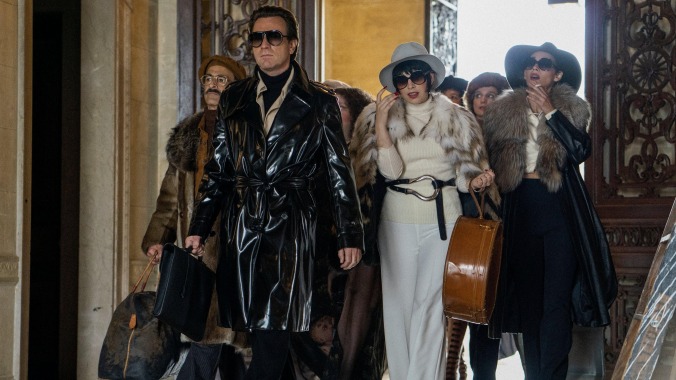But this five-part limited series is, like much of Halston’s and Murphy’s work, a collaboration—playwright Sharr White (Annapurna, The Other Place) created the series, which is based on Steven Gaines’ Simply Halston biography. Murphy writes and executive produces along with White and Scream Queens and The Politician scribe Ian Brennan. Another regular Murphy collaborator, American Crime Story and Hollywood director Daniel Minahan, helms the series. That Halston enjoyed having a coterie as much as Murphy adds another layer of symmetry: Where the designer had Elsa Peretti, Joe Eula, and his Halstonettes—including Pat Cleveland and Anjelica Huston—the multi-hyphenate has Brennan, Minahan, and stalwart cast members like Sarah Paulson and Evan Peters.
Surprisingly, Halston features none of the Murphy repertory players, but some of his other hallmarks are very much in place in this biographical drama: outsiders, power dynamics, queer leads, musical numbers. Though Halston is undeniably a group effort, built around Ewan McGregor’s oft-canny performance, it’s still destined to be dubbed a “Ryan Murphy show,” with all the baggage that comes with that term. And yet, the docudrama somehow manages to skimp on that “Murphy-ness”—it’s nowhere near as campy or heightened or as absurd as it ought to be, even if those qualities usually set Murphy’s shows up to go off the rails. When Bianca Jagger appears astride a horse in the middle of the dance floor, it’s in more of an obligatory “1970s’ greatest hits” compilation manner than a truly rococo moment. The story’s overindulgences are limited to coke-snorting scenes and utterances of “Halston,” which number in the hundreds. The sex scenes are often a whirl of clothes, which is maybe fitting. As exquisite as the limited series’ production and costume designs are, there’s more wonder and humor in one of the designer’s old perfume commercials.
The name Halston was, for a time, synonymous with the glitz and excess of the disco era. With his sleek, luxurious fashions and omnipresence at Studio 54 with lifelong friends like Liza Minnelli (played here with brio by Krysta Rodriguez), the American milliner turned designer helped make that scene. But by his own design, Halston’s influence quickly grew beyond nightclubs and ready-to-wear for Manhattan socialites to the summer Olympics and, ultimately and most damningly, JC Penney. White, Murphy, and Brennan, who penned the bulk of the series, emphasize Halston’s inner turmoil over becoming a brand, and later, a household name. That conflict can be a tough sell for a man who once said he wanted to “dress all of America.” The real Halston was incredibly ambitious—he had to be, in order to rebuild his empire time and again, going from pillbox hats to caftans to shirt dresses to perfume as objet d’art.
McGregor renders that fire as a controlled burn for much of the series’ five hours (which, as with so many streaming series, feels both overlong and insufficient). He mimics Halston’s cadence, fairly purring in the early goings, when the designer had only to speak to get his way. But, as he falls from his vaunted position as the founder of one of America’s first fashion houses, that purr becomes an incessant whine. McGregor’s stare and ability to turn smoking a cigarette into a one-act play are effective in his portrayal of a man once bent on world domination; if only the writing were as committed. Halston is wracked with doubt for the sake of doubt in one moment, seized by abandonment issues (maybe?) in another, then fairly gliding the next. The series moves unremittingly toward the future, allowing for only one extended glimpse at his past. Instead, Halston’s motivations—and those of his closest confidantes, like Liza, Joe (David Putti), and Victor (Gian Franco Rodriguez)—are made clear in the most plainspoken, exposition-laden dialogue. McGregor’s expressive countenance aside, most of the time, Halston’s state of mind is communicated in dialogue from other characters: “You’re out of control!” and “You’re a hit!”
There’s a way to harness that kind of Greek chorus, especially in a story of an artist whose trajectory, in some ways, followed that of Icarus. Halston’s work was exalted by fashion insiders and journalists and snapped up by consumers in equal measure—he achieved great critical and commercial success, spending a decade in the sun. The Greek tragedy actually invoked here is Persephone, which also provides Halston with a moment of redemption after years of churning out uninspired dreck (when he was working). Halston muses about mortality to his friend, Martha Graham (Mary Beth Peil), feeling himself only ever one step away from damnation—a notion undoubtedly informed by all the “hellfire and brimstone” sermonizing as the HIV/AIDS crisis began to take hold of the country. It’s a moving speech, and one of the more elegant ways the show underscores its themes. Yet Halston only reckons with the reality of the 1980s and early 1990s—that is, outside of the fashion and music—a handful of times.
It’s hard to fault Murphy, White, and Brennan for wanting to focus on Halston’s life; his triumphs, his loves (which are both heavily qualified). Pose, which Murphy co-created with Steven Canals and Brad Falchuk, similarly chooses to find the light in an overwhelmingly bleak period of history. But Halston isn’t a full-throated celebration, either. The show occasionally inches toward discussions about abusive geniuses, how praise can rob an artist of insight (not to mention talent), and the importance of retaining creative control (oh, and of reading a contract and not swooning over the mere mention of “licensing deals”) then quickly backs away. There’s a hesitation here that’s absent in the rest of Murphy’s work—and say what you will about his recent output, this was hardly the time to be restrained. By its end, including a typed coda that deflates the swell of emotion that immediately precedes it, Halston still looks like a sketch of what’s to come instead of a head-turning creation.










































